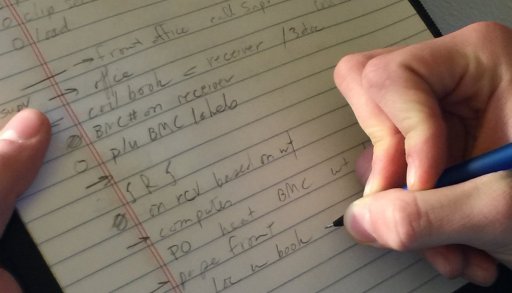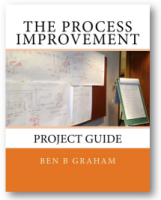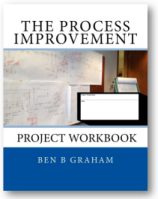Graham Process Mapping Software
Better Methods. Better Tools. Better Business Processes.
Do you see the forms, systems, spreadsheets, email... in your process maps?

Try Graham Process Mapping Software to SEE the detail...
Plain language process maps for the people who do the work
Graham Process Maps break down business process information flows to INDIVIDUAL documents (forms, records,
applications, systems, spreadsheets, email...) whatever is used to capture,
transmit or store data.
- They help YOU understand WHAT happens in the work flow.
- YOU see how every document/record contributes to the process;
what makes sense and what doesn't.
- YOU see every place data is captured; where it is captured and where it comes from.
- YOU see the impact of any changes you want to make before they are implemented; in a clear, visual
presentation.
- The maps use a notation that is intuitive to business users,
and can represent any process, however complex.
NO OTHER METHOD COMES CLOSE. PERIOD.
Enhance your
process improvement projects with Graham Process Maps?
Enhance Your Current Program With Detailed Process Maps
Any program (Six Sigma, Lean, TQM, Kaizen, Reengineering...) whose goal is to improve
the work you do, will benefit with a solid understanding of the current information work flows:
the documents that support the work,
the relationship between those documents,
who does the work,
where the work is done and how long it takes to do the work.
Only Graham Process Maps provide this information in a single picture.
A Graham Process Map never fails to impress.
"No other mapping software is able to so quickly and simply show the details of a work process..."
(read more...)
Harold Peters, P.Eng., Director of Performance Improvement, PeaceHealth
'Wow, where did you get these (flowcharts)?! This is great!'
(read more...)
Gordon M. Dykstra, Supervisor, Fare Product Distribution, Edmonton Transit System
What is a process map?
...and what is the difference between a process map, a process chart and a flowchart?
Call it a process chart, a flowchart or a process map, it doesn't matter. While they each had a different focus at
some point, today the terms are used interchangeably. The earliest description of a process chart was presented by
Frank and Lillian Gilbreth in a presentation to members of the American Society of Mechanical Engineers in 1921. They
said, "The Process Chart is a device for visualizing a process as a means of improving it." This is a simple,
straight-forward, plain-English definition of a process map. Since their introduction about a century ago, process charts have
come to have other uses. They are used to quickly understand a process (at least at a high level), they are used
for training, and they are used to satisfy audit, regulatory and certification requirements for process documentation
and transparency (some better than others). Rather than trying to incorporate these other uses into a definition
(and surely leave something out), a simpler description might be used...a tool for visualizing a process.
The tool the Gilbreths used was referred to as a Flow Process Chart or a Process Chart and the method was referred
to as Process Charting or Flowcharting. In the 1940's variants of the Flow Process Chart were introduced to office
work. The Multi-Column Flow Process Chart highlighted the different work areas that the process flowed through. The
Horizontal Process Chart or Procedure Flow Chart took
the Flow Process Chart idea and turned it on its side to show multiple flows and their relationships (This method was
developed and introduced by Ben S. Graham, Sr. in 1944 and is the method we use today.) Graham Charts or
detailed process charts, provide more detail than most,
displaying the flows and relationships of all of the many documents that make up a business process.
This type of detailed process map provides a deeper level uf process understanding compared with other
methods of process mapping.
In the 1960s, Flowcharting came into common usage in computer programming work. More specifically,
Program Flowcharts and Data Flowcharts were employed. These computer-related flowcharts, also known
as box and arrow flowcharts (where a box referred to an activity or process performed by a computer)
used a different set of symbols than the "Process Charts" that were used to document work process flows.
By the 1980s, the method and the name had expanded their usage beyond computer flows and into work flows
where it sacrificed visibility over individual documents for a simpler single-line flow. The single-line
flow led to the resurgence of the
multi-column chart, now referred to as a swimlane chart.
GE began Process Mapping in the late 1980s and the term 'process mapping' and the methods worked their way into common usage by the
mid-nineties. Originally, Process Maps referred to a hierarchical progression of flowcharts that started out
as an overview with just a few steps that could be decomposed to show more and more detail. IDEF0 charts, introduced
at Wright Patterson Air Force Base in the 1980s and the Six Sigma approach that starts with a SIPOC chart from which
analysts "drill down" to flowcharts with increasingly more detail represent hierarchical approaches to process mapping.
Graham Process Maps add a level of clarity to process understanding that isn't available in most maps. They are
an excellent addition to the Six Sigma and Lean practitioners' tool box.
Today, while certain flowchart terms bring to mind specific chart variations (i.e. SIPOC chart and Swimlane diagram),
the more generic terms Process Chart, Flowchart, and Process Map are interchangeable and cover a wide variation
in the symbols used and the level of detail.
Get your Step-by-Step Manual for Identifying, Assessing and Measurably Improving Business Processes...
Includes 9 checklists, 7 cost worksheets, a Project Agreement form and and 2 forms to support implementation of the new methods!





